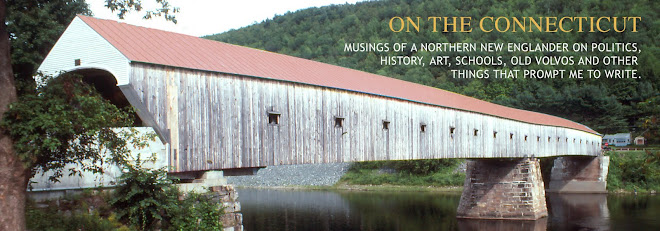I'm just a gigolo...
-
OK. The truth be told, I guess I was a gigolo at one time.
I wasn't trying to be. But a woman I had sex with paid me for my time. It
started cuz I missed w...
Monday, August 21, 2023
50 Barn Cupolas
I have been photographing barns for more than 40 years. During that time, I noticed that many old barns have elaborate cupolas. So I began shooting close-ups of the cupolas.
I selected fifty of the most interesting ones to include in my new book, 50 Barn Cupolas. Each cupola is different, and each one expresses the pride that its original owner took in his barn. Some have been lovingly restored – others are on their last legs.
The book explains how old New England dairy barns came to have cupolas. It takes you back to the nineteenth century when dairy farmers turned a ventilation problem into an opportunity to express their individuality. It also documents the way fifty nineteenth-century carpenters creatively executed the same project.
50 Barn Cupolas is available in both digital and printed versions.
I selected fifty of the most interesting ones to include in my new book, 50 Barn Cupolas. Each cupola is different, and each one expresses the pride that its original owner took in his barn. Some have been lovingly restored – others are on their last legs.
The book explains how old New England dairy barns came to have cupolas. It takes you back to the nineteenth century when dairy farmers turned a ventilation problem into an opportunity to express their individuality. It also documents the way fifty nineteenth-century carpenters creatively executed the same project.
50 Barn Cupolas is available in both digital and printed versions.
Sunday, February 19, 2023
Barn Cupolas
The word cupola is derived from the Greek word kupellon (a small cup) and the Latin cupella (a vault resembling an upside-down cup).
Cupolas evolved during the Renaissance and became extremely important architectural elements. They spread across Europe and became status symbols placed atop government buildings and the homes of royalty.
Cupolas served various purposes, but they were primarily used to add aesthetic appeal to the building they topped. Larger cupolas were sometimes accessible via an interior stairway, giving occupants a vantage point to look out over their surroundings. Smaller cupolas, known as lanterns, were often designed to provide extra illumination for the space below.
Cupolas were produced in various shapes and sizes but were commonly square or hexagonal and much smaller than the structure to which they’re attached. Large, extravagant cupolas appear on some of the world’s greatest buildings and are often dome-shaped and large enough to be a major architectural feature on a building.
As dairy farms grew larger in the late 1800s, they began storing more hay. Intense heat could build up to the point of spontaneous combustion when fresh air was cut off from a barn full of hay, destroying both the hay and the barn. And stale air didn’t just smell bad. A source of oxygen was needed to replenish the air consumed by humans and animals.
Cupolas became an iconic feature on barns because they provided a means for heat to escape and fresh air to enter. Classic barn cupolas were mounted over a hole in the roof and usually louvered to catch the wind that was forced up the sides of a slanted roof. The fresh air flowed through the cupola and down into the barn. The downward angle of the louvers kept rainwater out while allowing fresh air in. Cupolas also provided enough air to allow hay to naturally dry while stored in the barn.
Farmers took great pride in their barns. They were the biggest single investment farmers made, so it’s understandable that many put elaborate cupolas on their barns to make a statement about their pride and prosperity.
Cupolas evolved during the Renaissance and became extremely important architectural elements. They spread across Europe and became status symbols placed atop government buildings and the homes of royalty.
Cupolas served various purposes, but they were primarily used to add aesthetic appeal to the building they topped. Larger cupolas were sometimes accessible via an interior stairway, giving occupants a vantage point to look out over their surroundings. Smaller cupolas, known as lanterns, were often designed to provide extra illumination for the space below.
Cupolas were produced in various shapes and sizes but were commonly square or hexagonal and much smaller than the structure to which they’re attached. Large, extravagant cupolas appear on some of the world’s greatest buildings and are often dome-shaped and large enough to be a major architectural feature on a building.
As dairy farms grew larger in the late 1800s, they began storing more hay. Intense heat could build up to the point of spontaneous combustion when fresh air was cut off from a barn full of hay, destroying both the hay and the barn. And stale air didn’t just smell bad. A source of oxygen was needed to replenish the air consumed by humans and animals.
Cupolas became an iconic feature on barns because they provided a means for heat to escape and fresh air to enter. Classic barn cupolas were mounted over a hole in the roof and usually louvered to catch the wind that was forced up the sides of a slanted roof. The fresh air flowed through the cupola and down into the barn. The downward angle of the louvers kept rainwater out while allowing fresh air in. Cupolas also provided enough air to allow hay to naturally dry while stored in the barn.
Farmers took great pride in their barns. They were the biggest single investment farmers made, so it’s understandable that many put elaborate cupolas on their barns to make a statement about their pride and prosperity.
Monday, February 6, 2023
Farm Silos
Silos were first used on farms in the 1880s to store silage, a moist and fermented fodder made from a variety of plant materials and primarily fed to cows. Silage had higher energy and protein levels than dried hay, making it possible for dairy farmers to keep their cows in reliable milk production during the winter months and provide year-round income.
Storing silage for several months involved keeping moisture levels high while keeping oxygen levels to a minimum so fermentation could take place. Round wood silos became popular because they minimized air leakage. Their vertical staves were held tightly in place by iron bands, equalizing the outward pressure and eliminating interior corners where the silage could spoil.
The fermentation process unfortunately produced silage acids that gradually deteriorated the silo. By 1900, wood silos began to be replaced by other materials that were more resistant to deterioration from silage seepage like masonry, steel and even glass. These newer silos produced better results but don’t have the visual appeal of the early wood silos.
Storing silage for several months involved keeping moisture levels high while keeping oxygen levels to a minimum so fermentation could take place. Round wood silos became popular because they minimized air leakage. Their vertical staves were held tightly in place by iron bands, equalizing the outward pressure and eliminating interior corners where the silage could spoil.
The fermentation process unfortunately produced silage acids that gradually deteriorated the silo. By 1900, wood silos began to be replaced by other materials that were more resistant to deterioration from silage seepage like masonry, steel and even glass. These newer silos produced better results but don’t have the visual appeal of the early wood silos.
Wednesday, February 1, 2023
Subscribe to:
Comments (Atom)




















